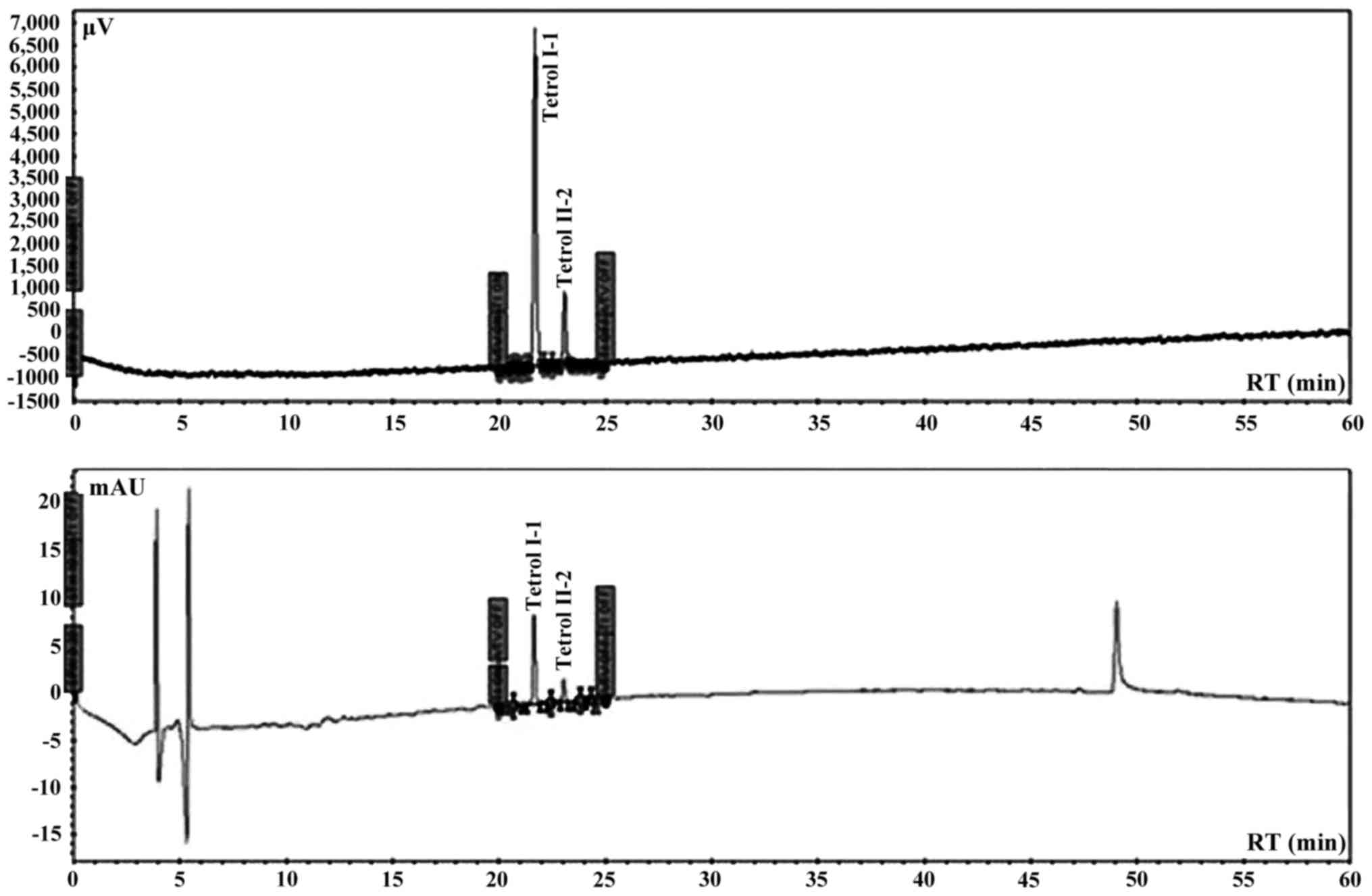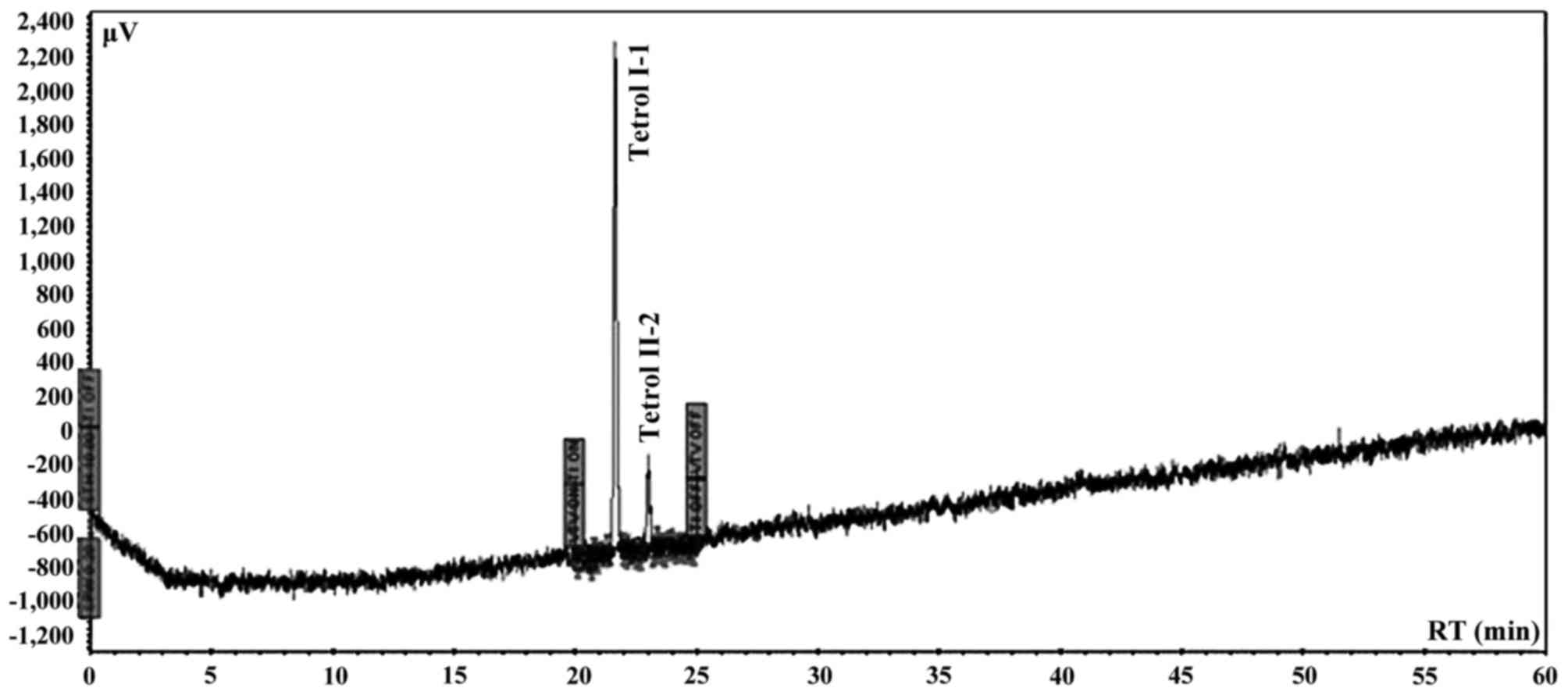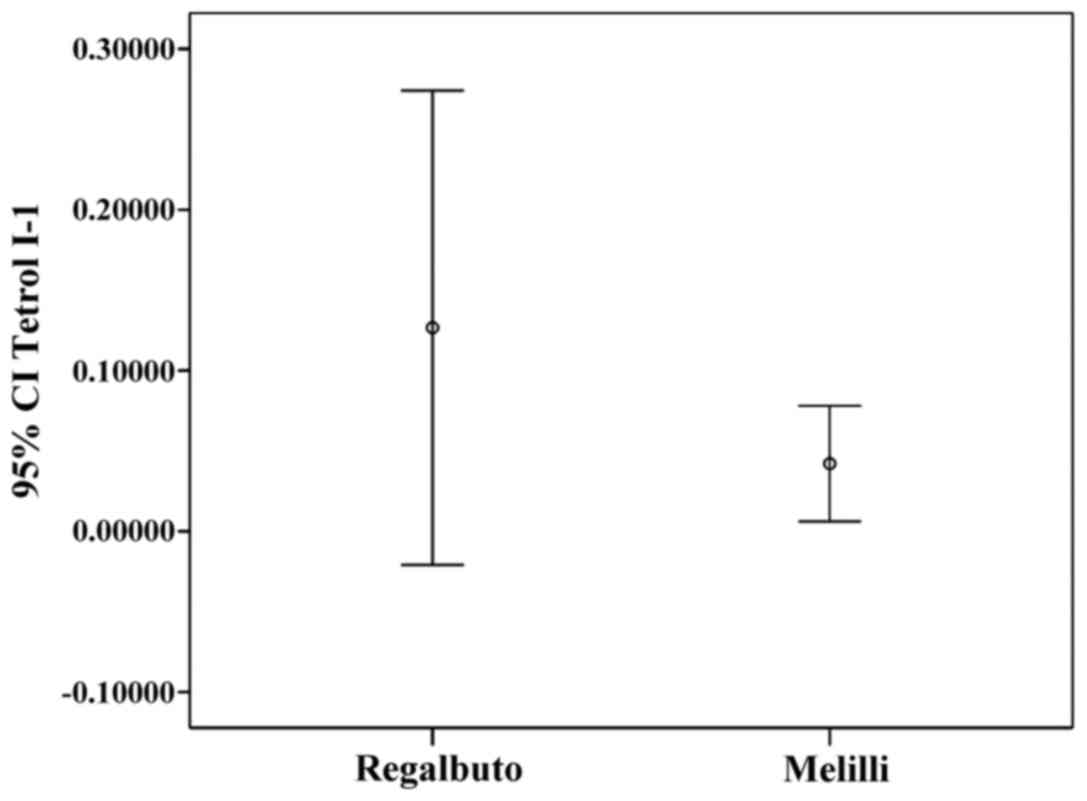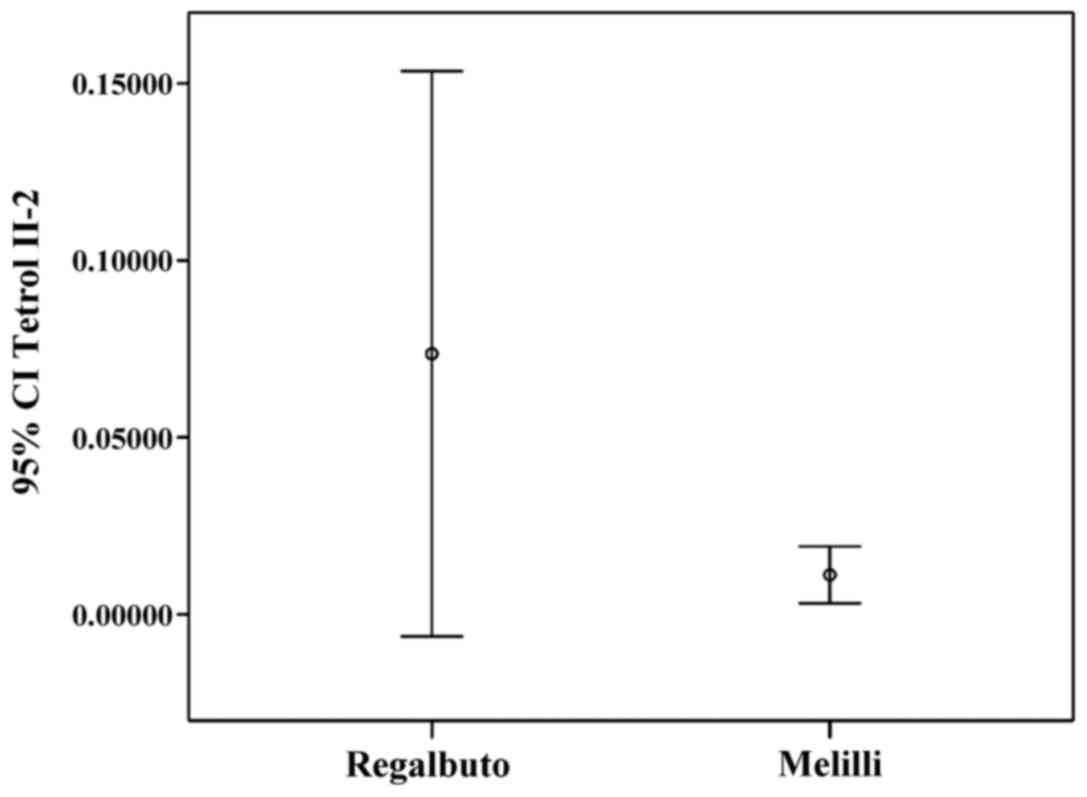|
1
|
Guerreiro CBB, Horálek J, de Leeuw F and
Couvidat F: Benzo(a)pyrene in Europe: Ambient air concentrations,
population exposure and health effects. Environ Pollut.
214:657–667. 2016. View Article : Google Scholar : PubMed/NCBI
|
|
2
|
Sciacca S and Conti Oliveri G: Mutagens
and carcinogens in drinking water. Med J Nutrition Metab.
2:157–162. 2009. View Article : Google Scholar
|
|
3
|
Conte F, Copat C, Longo S, Conti G, Grasso
A, Arena G, Dimartino A, Brundo MV and Ferrante M: Polycyclic
aromatic hydrocarbons in Haliotis tuberculata (Linnaeus,
1758) (Mollusca, Gastropoda): Considerations on food safety and
source investigation. Food Chem Toxicol. 94:57–63. 2016. View Article : Google Scholar : PubMed/NCBI
|
|
4
|
International Agency for Research on
Cancer (IARC): Chemical Agents and Related OccupationsIARC
Monographs. 100F. International Agency for Research on Cancer;
Lyon: 2012
|
|
5
|
Liou GY and Storz P: Reactive oxygen
species in cancer. Free Radic Res. 44:479–496. 2010. View Article : Google Scholar : PubMed/NCBI
|
|
6
|
Ferecatu I, Borot MC, Bossard C, Leroux M,
Boggetto N, Marano F, Baeza-Squiban A and Andreau K: Polycyclic
aromatic hydrocarbon components contribute to the
mitochondria-antiapoptotic effect of fine particulate matter on
human bronchial epithelial cells via the aryl hydrocarbon receptor.
Part Fibre Toxicol. 21:(7). 182010. View Article : Google Scholar
|
|
7
|
Signorelli SS, Anzaldi M, Libra M,
Navolanic PM, Malaponte G, Mangano K, Quattrocchi C, Di Marco R,
Fiore V and Neri S: Plasma levels of inflammatory biomarkers in
peripheral arterial disease: Results of a cohort study. Angiology.
67:870–874. 2016. View Article : Google Scholar : PubMed/NCBI
|
|
8
|
Yang L, Liu G, Lin Z, Wang Y, He H, Liu T
and Kamp DW: Pro-inflammatory response and oxidative stress induced
by specific components in ambient particulate matter in human
bronchial epithelial cells. Environ Toxicol. 31:923–936. 2016.
View Article : Google Scholar : PubMed/NCBI
|
|
9
|
Signorelli SS, Fatuzzo P, Rapisarda F,
Neri S, Ferrante M, Conti Oliveri G, Fallico R, Di Pino L, Pennisi
G, Celotta G, et al: A randomised, controlled clinical trial
evaluating changes in therapeutic efficacy and oxidative parameters
after treatment with propionyl L-carnitine in patients with
peripheral arterial disease requiring haemodialysis. Drugs Aging.
23:263–270. 2006. View Article : Google Scholar : PubMed/NCBI
|
|
10
|
Signorelli SS, Fatuzzo P, Rapisarda F,
Neri S, Ferrante M, Conti Oliveri G, Fallico R, Di Pino L, Pennisi
G, Celotta G, et al: Propionyl-L-carnitine therapy: Effects on
endothelin-1 and homocysteine levels in patients with peripheral
arterial disease and end-stage renal disease. Kidney Blood Press
Res. 29:100–107. 2006. View Article : Google Scholar : PubMed/NCBI
|
|
11
|
Alexandrov K, Sala M and Rojas M:
Differences in the DNA adducts formed in cultured rabbit and rat
dermal fibroblasts by benzo(a)pyrene and
(−)benzo(a)pyrene-7,8-diol. Cancer Res. 48:7132–7139.
1988.PubMed/NCBI
|
|
12
|
U.S. Environmental Protection Agency
(EPA): Toxicity and Exposure Assessment for Children's Health
(TEACH). https://archive.epa.gov/region5/teach/web/html/index.htmlAccessed.
January 10–2017.
|
|
13
|
Tang D, Li T, Liu JJ, Chen J, Qu L and
Perera F: PAH-DNA adducts in cord blood and fetal and child
development in a Chinese cohort. Environ Health Perspect.
114:1297–1300. 2006. View
Article : Google Scholar : PubMed/NCBI
|
|
14
|
United States Environmental Protection
Agency (U.S. EPA): IRIS Toxicological Review of Benzo[a]pyrene
(Final Report)U.S. Environmental Protection Agency. Washington, DC:
EPA/635/R-17/003F. 2017, https://cfpub.epa.gov/si/si_public_record_report.cfm?dirEntryId=329750
|
|
15
|
Perera FP, Chang HW, Tang D, Roen EL,
Herbstman J, Margolis A, Huang TJ, Miller RL, Wang S and Rauh V:
Early-life exposure to polycyclic aromatic hydrocarbons and ADHD
behavior problems. PLoS One. 5:e1116702014. View Article : Google Scholar
|
|
16
|
Perera FP, Tang D, Wang S, Vishnevetsky J,
Zhang B, Diaz D, Camann D and Rauh V: Prenatal polycyclic aromatic
hydrocarbon (PAH) exposure and child behavior at age 6–7 years.
Environ Health Perspect. 120:921–926. 2012. View Article : Google Scholar : PubMed/NCBI
|
|
17
|
Gaspari L, Chang SS, Santella RM, Garte S,
Pedotti P and Taioli E: Polycyclic aromatic hydrocarbon-DNA adducts
in human sperm as a marker of DNA damage and infertility. Mutat
Res. 535:155–160. 2003. View Article : Google Scholar : PubMed/NCBI
|
|
18
|
Zenzes MT, Bielecki R and Reed TE:
Detection of benzo(a)pyrene diol epoxide-DNA adducts in sperm of
men exposed to cigarette smoke. Fertil Steril. 72:330–335. 1999.
View Article : Google Scholar : PubMed/NCBI
|
|
19
|
Rutstein SO and Shah IH: Infecundity,
infertility, and childlessness in developing countries. DHS
Comparative Reports No 9ORC Macro and the World Health
Organization. Calverton, MD: 2004
|
|
20
|
Kumar N and Singh AK: Trends of male
factor infertility, an important cause of infertility: A review of
literature. J Hum Reprod Sci. 8:191–196. 2015. View Article : Google Scholar : PubMed/NCBI
|
|
21
|
World Health Organization (WHO): WHO
Laboratory Manual for the Examination and Processing of Human
Semen. 5th. WHO Press; Geneva: pp. 1–271. 2010
|
|
22
|
Alexandrov K, Rojas M, Geneste O,
Castegnaro M, Camus AM, Petruzzelli S, Giuntini C and Bartsch H: An
improved fluorometric assay for dosimetry of benzo(a)pyrene
diol-epoxide-DNA adducts in smokers' lung: Comparisons with total
bulky adducts and aryl hydrocarbon hydroxylase activity. Cancer
Res. 52:6248–6253. 1992.PubMed/NCBI
|
|
23
|
Hayakawa K: Environmental behaviors and
toxicities of polycyclic aromatic hydrocarbons and nitropolycyclic
aromatic hydrocarbons. Chem Pharm Bull (Tokyo). 64:83–94. 2016.
View Article : Google Scholar : PubMed/NCBI
|
|
24
|
Conti GO, Copat C, Ledda C, Fiore M,
Fallico R, Sciacca S and Ferrante M: Evaluation of heavy metals and
polycyclic aromatic hydrocarbons (PAHs) in Mullus barbatus
from Sicily channel and risk-based consumption limits. Bull Environ
Contam Toxicol. 88:946–950. 2012. View Article : Google Scholar : PubMed/NCBI
|
|
25
|
Phillips DH and Venitt S: DNA and protein
adducts in human tissues resulting from exposure to tobacco smoke.
Int J Cancer. 131:2733–2753. 2012. View Article : Google Scholar : PubMed/NCBI
|
|
26
|
Gilberson T, Peluso ME, Munia A,
Luján-Barroso L, Sánchez MJ, Navarro C, Amiano P, Barricarte A,
Quirós JR, Molina-Montes E, et al: Aromatic adducts and lung cancer
risk in the European Prospective Investigation into Cancer and
Nutrition (EPIC) Spanish cohort. Carcinogenesis. 35:2047–2054.
2014. View Article : Google Scholar : PubMed/NCBI
|
|
27
|
Palli D, Saieva C, Munnia A, Peluso M,
Grechi D, Zanna I, Caini S, Decarli A, Sera F and Masala G: DNA
adducts and PM(10) exposure in traffic-exposed workers and urban
residents from the EPIC-Florence City study. Sci Total Environ.
403:105–112. 2008. View Article : Google Scholar : PubMed/NCBI
|
|
28
|
Jayachandran S: Air quality and early-life
mortality: Evidence from Indonesia's wildfires. J Hum Resour.
44:916–954. 2009. View Article : Google Scholar
|
|
29
|
Conti Oliveri G, Heibati B, Kloog I, Fiore
M and Ferrante M: A review of AirQ Models and their applications
for forecasting the air pollution health outcomes. Environ Sci
Pollut Res Int. Jan 4–2017.(Epub ahead of print). PubMed/NCBI
|
|
30
|
Miri M, Derakhshan Z, Allahabadi A, Ahmadi
E, Conti Oliveri G, Ferrante M and Aval HE: Mortality and morbidity
due to exposure to outdoor air pollution in Mashhad metropolis,
Iran. The AirQ model approach. Environ Res. 151:451–457. 2016.
View Article : Google Scholar : PubMed/NCBI
|
|
31
|
Ghozikali Ghanbari M, Heibati B, Naddafi
K, Kloog I, Conti Oliveri G, Polosa R and Ferrante M: Evaluation of
Chronic Obstructive Pulmonary Disease (COPD) attributed to
atmospheric O3, NO2, and SO2 using
Air Q Model (2011–2012 year). Environ Res. 144:99–105. 2016.
View Article : Google Scholar : PubMed/NCBI
|
|
32
|
Wang Y, Kloog I, Coull BA, Kosheleva A,
Zanobetti A and Schwartz JD: Estimating causal effects of long-term
PM2.5 exposure on mortality in New Jersey. Environ Health Perspect.
124:1182–1188. 2016. View Article : Google Scholar : PubMed/NCBI
|
|
33
|
Nieuwenhuijsen MJ, Basagaña X, Dadvand P,
Martinez D, Cirach M, Beelen R and Jacquemin B: Air pollution and
human fertility rates. Environ Int. 70:9–14. 2014. View Article : Google Scholar : PubMed/NCBI
|
|
34
|
Frutos V, González-Comadrán M, Solà I,
Jacquemin B, Carreras R and Checa Vizcaíno MA: Impact of air
pollution on fertility: A systematic review. Gynecol Endocrinol.
31:7–13. 2015. View Article : Google Scholar : PubMed/NCBI
|














